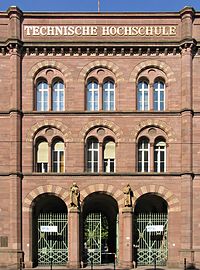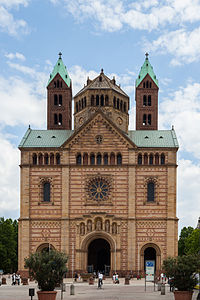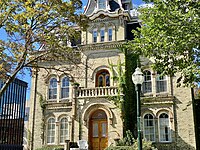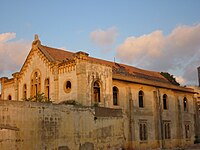Germanic architectural style
 Entrance to the main building of Karlsruhe Polytechnic (Heinrich Hübsch, 1833–35)
Entrance to the main building of Karlsruhe Polytechnic (Heinrich Hübsch, 1833–35)
 West facade of the Speyer Cathedral, rebuilt 1854–58 by Heinrich Hübsch
West facade of the Speyer Cathedral, rebuilt 1854–58 by Heinrich Hübsch
 Carrie Pierce House in Madison, Wisconsin (August Kutzbock and Samuel Donnel, 1857)
Carrie Pierce House in Madison, Wisconsin (August Kutzbock and Samuel Donnel, 1857)
 Van Slyke / Keenan House in Madison, Wisconsin (August Kutzbock, 1858)
Van Slyke / Keenan House in Madison, Wisconsin (August Kutzbock, 1858)
 Gates of Heaven Synagogue in Madison, Wisconsin (August Kutzbock, 1863)
Gates of Heaven Synagogue in Madison, Wisconsin (August Kutzbock, 1863)
 Temple Israel in Lafayette, Indiana (1867)
Temple Israel in Lafayette, Indiana (1867)
 Temple Emanu-El in Milwaukee, Wisconsin (1872)
Temple Emanu-El in Milwaukee, Wisconsin (1872)
 Maghen Abraham Synagogue in Beirut, Lebanon (1925)
Maghen Abraham Synagogue in Beirut, Lebanon (1925)
 Leibniz University in Hanover, Germany (1857–66), southern facade
Leibniz University in Hanover, Germany (1857–66), southern facade
 Leibniz University Hanover, northern facade
Leibniz University Hanover, northern facade
 Franklin School (Washington, D.C.) (1869)
Franklin School (Washington, D.C.) (1869)
Rundbogenstil (round-arch style) is a nineteenth-century historic revival style of architecture popular in the German-speaking lands and the German diaspora. It combines elements of Byzantine, Romanesque, and Renaissance architecture with particular stylistic motifs.[1] It forms a German branch of Romanesque Revival architecture sometimes used in other countries.
- ^ Strauss, Gerhard & Olbrich, Harald: "Eintrag Rundbogenstil." Lexikon der Kunst. Architektur, bildende Kunst, angewandte Kunst, Industrieformgestaltung, Kunsttheorie. (in German.) Leipzig: Seemann. Band 6, p. 293 ff.










